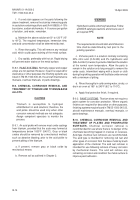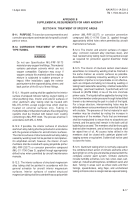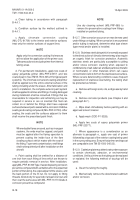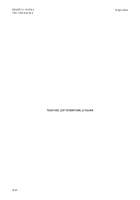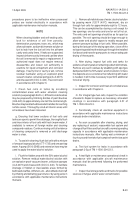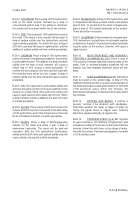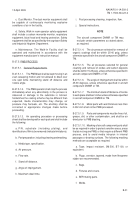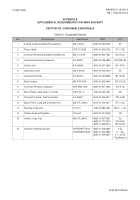TM-1-1500-344-23-2 - Page 226 of 240
B-24
NAVAIR 01-1A-509-2
TM 1-1500-344-23-2
15 April 2009
s. To avoid future fungus contamination, use only
military specification turbine fuel, which contains a
biocidal agent (MIL-DTL-85470), or add this agent
according to accepted commercial methods noted on
the biocidal container when refueling with non-military
fuel.
B-21. REMOVAL
OF
MICROBIOLOGICAL
GROWTHS.
WARNING
Open all circuit breakers associated with battery
power (refer to applicable maintenance
manuals) prior to application of isopropyl alcohol
(TT-I-735). Do not use synthetic wiping cloths
with flammable solvents such as isopropyl
alcohol. Observe personal precautionary and
protective measures. Use chemical or splash
proof goggles and rubber gloves when working
with tri-basic sodium phosphate (O-S-642).
When solution is splashed into eyes,
immediately flush thoroughly with water and
report to dispensary.
CAUTION
The use of strong tri-basic sodium phosphate
(O-S-642) is not recommended for removing
paint from wood surfaces, since the solution will
attack the fibers, causing swelling and
discoloration.
B-21.1. Fungus growth such as mildew and mold occur
on organic materials (plastic and oil), and on organic
coatings (paints) or deposits on the surface of inorganic
(metal and concrete) materials, particularly in damp,
warm climates.
B-21.2. MICROBIOLOGICAL
GROWTH
ON
PLASTICS. Since the term plastics includes compounds
of different chemical compositions varying widely in
chemical and physical properties, one type of plastic
may be cleaned by a method which may be destructive
to another type of plastic. In general, organic solvents,
including petroleum solvents such as dry cleaning solvent
and mineral spirits paint thinner, should not be used to
clean plastics or allowed to come in contact with plastics.
Plastics are cleaned by wiping with a lint-free cloth or
sponge moistened with clean water or a solution of two
ounces by weight of detergent (P-D-410) per gallon of
water. Plastics are polished by rubbing with ground
abrasive technical pumice (SS-P-821). Other cleaning
methods can be used for certain types of plastics.
B-21.2.1.
Acrylate and Methacrylate Resin Plastics
(Plexiglas). These plastics are cleaned by washing with
a solution containing one ounce of general purpose
detergent (MIL-D-16791) in one gallon of water. Wipe
area with a flannel cloth.
B-21.2.2.
Plastic Electrical Insulation. Clean plastic
electrical insulation by wiping with a lint-free cloth or
sponge moistened with isopropyl alcohol TT-I-735).
B-21.3. PAINTED AND UNPAINTED METAL
SURFACES.
B-21.3.1.
Fungus Growth. Fungus growth is removed
from painted and unpainted metal surfaces by scrubbing
with a solution of two ounces by weight of detergent
(P-D-410) per gallon of water. When fungus cannot be
removed from unpainted surfaces by scrubbing with
detergent, mechanical removal is recommended in
accordance with Chapter 4 of this manual.
B-21.3.2.
Mildew. Mildew may be produced by fungus
growing on organic matter adhering to a soft paint film
or on the paint oil itself. Remove mildew by scrubbing
with a water solution of tribasic sodium phosphate
(O-S-642).
a. A strong phosphate solution (three pounds per 10
gallons of water) is most effective, but the solution
should be applied to small areas of the surface at a time,
rinsed off immediately with clean water, and dried with
a wiping cloth. When allowed to remain on the painted
surface for several minutes, the solution will loosen the
paint and may attack the wood fibers.
b. Scrubbing the surface with a mild phosphate
solution (2
1
⁄
2
ounces by weight per 10 gallons of water)
will not loosen the paint and is less effective in removing
the mildew. Rinse the surface thoroughly to remove
residue.
c. To prevent recurrence of mildew, the old paint
system should be removed in accordance with
TM 55-1500-345-23.
Back to Top

